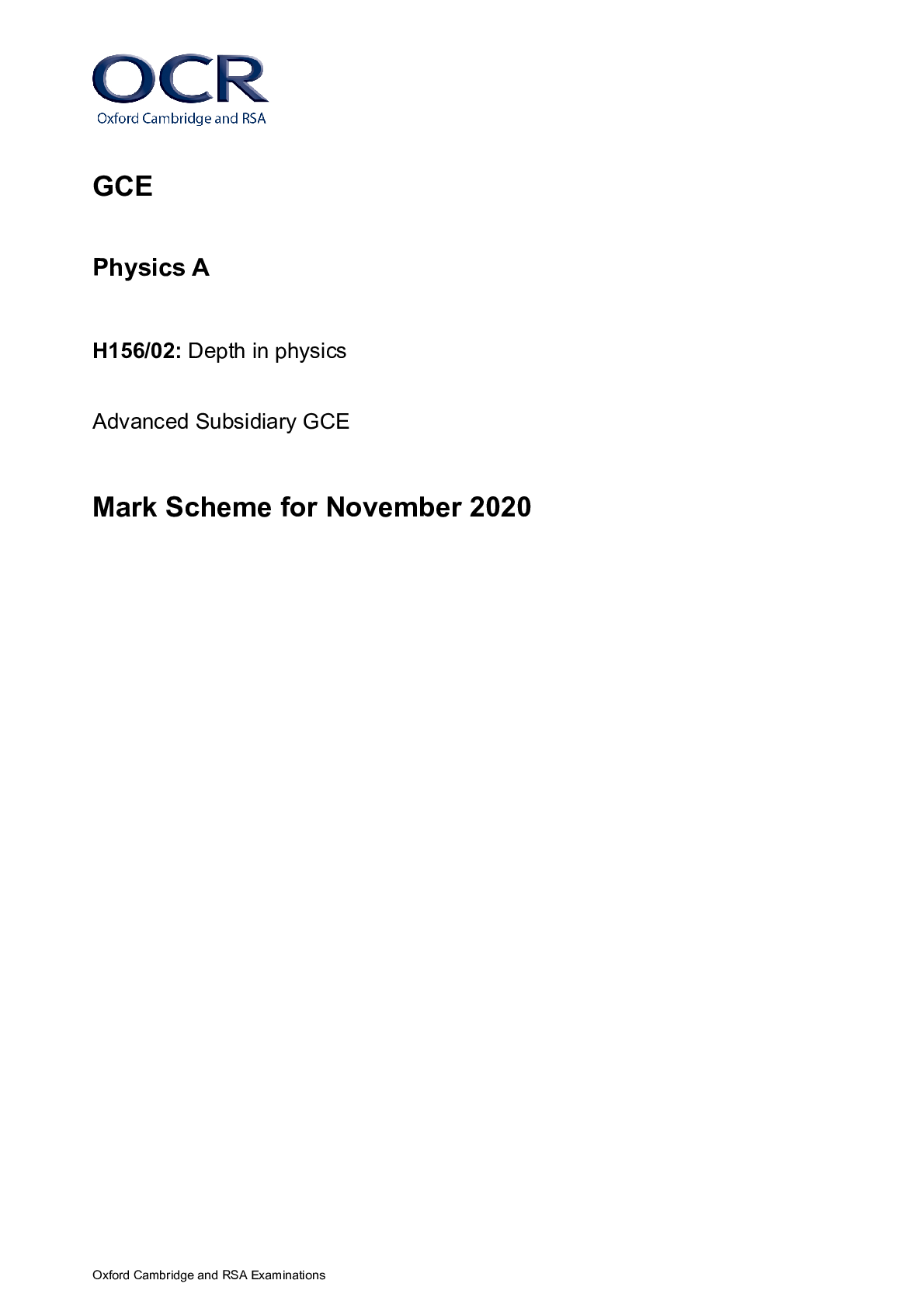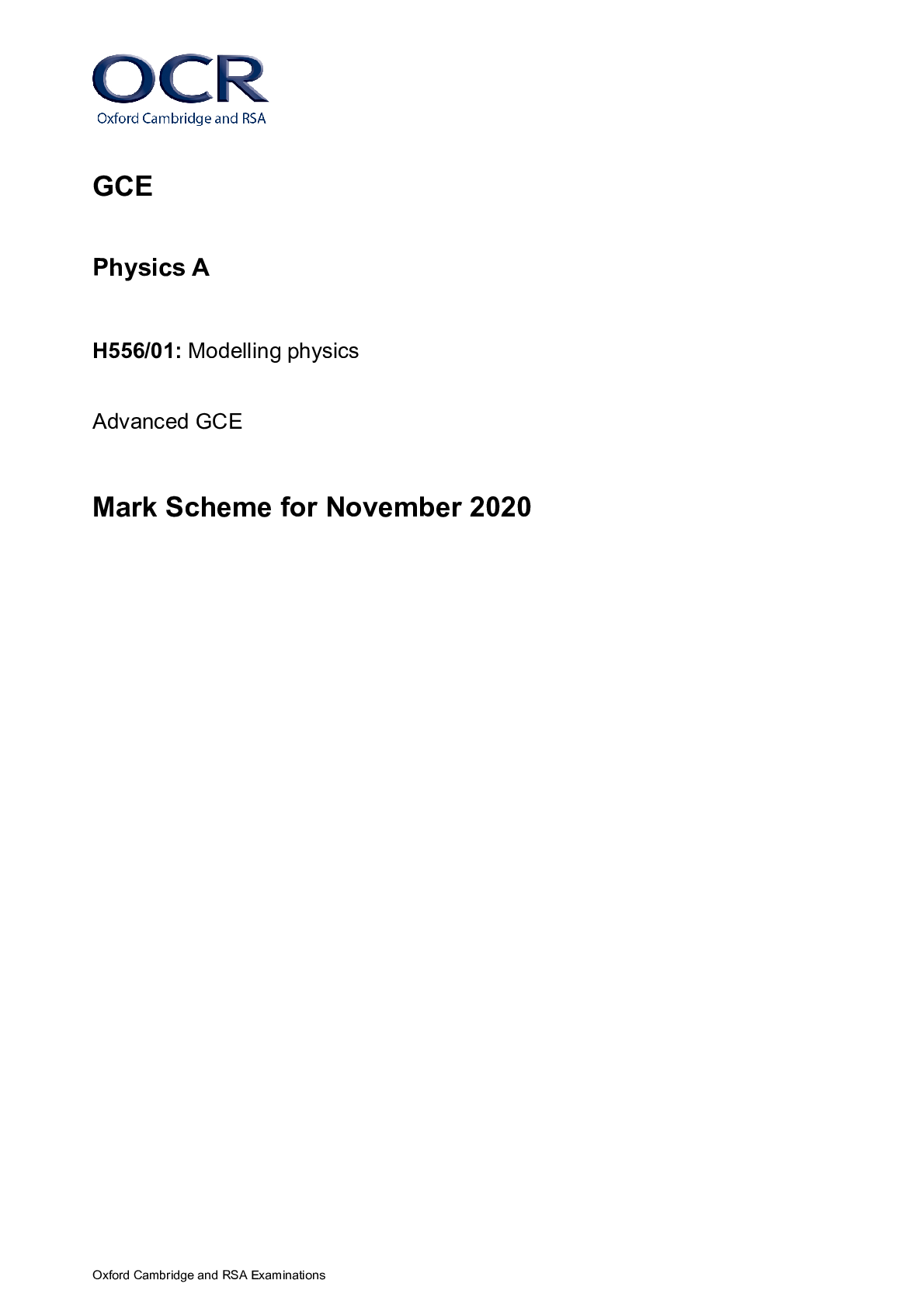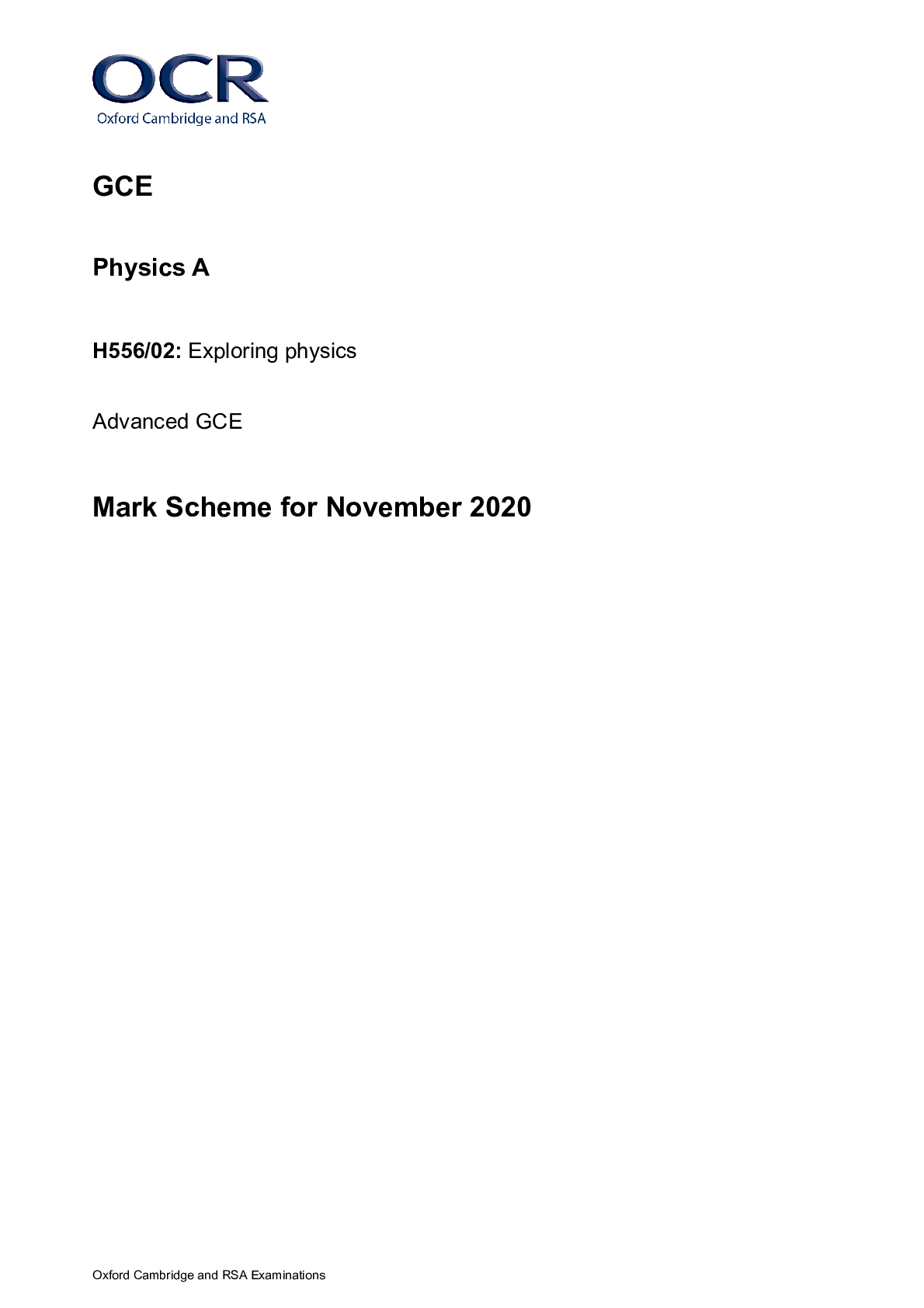English > AS Mark Scheme > GCE English Language and Literature (EMC) H474/01: Exploring non-fiction and spoken texts Advanced G (All)
GCE English Language and Literature (EMC) H474/01: Exploring non-fiction and spoken texts Advanced GCE Mark Scheme for November 2020
Document Content and Description Below
Oxford Cambridge and RSA Examinations GCE English Language and Literature (EMC) H474/01: Exploring non-fiction and spoken texts Advanced GCE Mark Scheme for November 2020Oxford Cambridge and RSA ... Examinations OCR (Oxford Cambridge and RSA) is a leading UK awarding body, providing a wide range of qualifications to meet the needs of candidates of all ages and abilities. OCR qualifications include AS/A Levels, Diplomas, GCSEs, Cambridge Nationals, Cambridge Technicals, Functional Skills, Key Skills, Entry Level qualifications, NVQs and vocational qualifications in areas such as IT, business, languages, teaching/training, administration and secretarial skills. It is also responsible for developing new specifications to meet national requirements and the needs of students and teachers. OCR is a not-for-profit organisation; any surplus made is invested back into the establishment to help towards the development of qualifications and support, which keep pace with the changing needs of today’s society. This mark scheme is published as an aid to teachers and students, to indicate the requirements of the examination. It shows the basis on which marks were awarded by examiners. It does not indicate the details of the discussions which took place at an examiners’ meeting before marking commenced. All examiners are instructed that alternative correct answers and unexpected approaches in candidates’ scripts must be given marks that fairly reflect the relevant knowledge and skills demonstrated. Mark schemes should be read in conjunction with the published question papers and the report on the examination. © OCR 2020H474/01 Mark Scheme November 2020 2 Annotations Annotation Meaning Blank Page – this annotation must be used on all blank pages within an answer booklet (structured or unstructured) and on each page of an additional object where there is no candidate response. Positive Recognition Assessment Objective 1 Assessment Objective 2 Assessment Objective 3 Assessment Objective 4 Assessment Objective 5 Attempted or insecure Analysis Detailed Effect Expression Link Answering the question View Relevant but broad, general or implicitH474/01 Mark Scheme November 2020 3 Subject-specific marking instructions Candidates answer Question 1. Assessment objectives AO1, AO2, AO3 and AO4 are assessed in this question. The question-specific notes on the task provide an indication of what candidates are likely to cover in terms of AOs 1, 2, 3 and 4. The level descriptors are organised with the dominant assessment objective first; for this question, AO4 followed by AO1, AO3 and AO2. The notes are neither prescriptive nor exhaustive: candidates should be rewarded for any relevant response which appropriately addresses the Assessment Objectives. INTRODUCTION Your first task as an Examiner is to become thoroughly familiar with the material on which the examination depends. This material includes: • the specification, especially the assessment objectives • the question paper and its rubrics • the texts which candidates have studied • the mark scheme. You should ensure that you have copies of these materials. You should ensure also that you are familiar with the administrative procedures related to the marking process. These are set out in the OCR booklet Instructions for Examiners. Please ask for help or guidance whenever you need it. Your first point of contact is your Team Leader. Awarding Marks (i) There is one question worth 32 marks. (ii) Award a single overall mark out of 32, following this procedure: • refer to the question-specific Guidance for descriptions of Higher and Lower response and indicative content • using ‘best fit’, make a holistic judgement to locate the answer in the appropriate level descriptorH474/01 Mark Scheme November 2020 4 • place the answer precisely within the level and determine the appropriate mark out of 32 considering the relevant AOs • bear in mind the weighting of the AOs, and place the answer within the level and award the appropriate mark out of 32 • there should be clear evidence of candidates’ response to AO4, AO1, AO3 and AO2. If a candidate does not address one of the assessment objectives they cannot achieve all of the marks in the given level. Mark positively. Use the lowest mark in the level only if the answer is borderline / doubtful. Use the full range of marks, particularly at the top and bottom ends of the mark range. USING THE MARK SCHEME Study this Mark Scheme carefully. The Mark Scheme is an integral part of the process that begins with the setting of the question paper and ends with the awarding of grades. Question Papers and Mark Schemes are developed in association with each other so that issues of differentiation and positive achievement can be addressed from the very start. This Mark Scheme is a working document; it is not exhaustive; it does not provide ‘correct’ answers. The Mark Scheme can only provide ‘best guesses’ about how the question will work out, and it is subject to revision after we have looked at a wide range of scripts. The Examiners’ Standardisation Meeting will ensure that the Mark Scheme covers the range of candidates’ responses to the questions, and that all Examiners understand and apply the Mark Scheme in the same way. The Mark Scheme will be discussed and amended at the meeting, and administrative procedures will be confirmed. Co-ordination scripts will be issued at the meeting to exemplify aspects of candidates’ responses and achievements; the co-ordination scripts then become part of this Mark Scheme. Before the Standardisation Meeting, you should read and mark in pencil a number of scripts, in order to gain an impression of the range of responses and achievement that may be expected. In your marking, you will encounter valid responses which are not covered by the Mark Scheme: these responses must be credited. You will encounter answers which fall outside the ‘target range’ of Bands for the paper which you are marking. Please mark these answers according to the marking criteria. Please read carefully all the scripts in your allocation and make every effort to look positively for achievement throughout the ability range. Always be prepared to use the full range of marks.H474/01 Mark Scheme November 2020 5 The weightings for the assessment objectives are: AO4 5% AO1 4% AO3 4% AO2 3% Total 16% The dominant assessment objective is AO4 Explore connections across texts informed by linguistic and literary concepts and methods. Answers will also be assessed for AO1, AO3 and AO2. Answers should explore connections across the texts, considering similarities and differences, informed by linguistic concepts and methods (AO4). They should develop a coherent argument, using relevant concepts and methods from linguistic and literary study and associated terminology (AO1). Answers should be developed with reference to contextual factors (AO3) and explore the ways speakers and writers shape meanings (AO2). The criteria below are organised to reflect the order of the dominant assessment objectives. A response that does not address any one of the four assessment objectives targeted cannot achieve all of the marks in the given level. Level 6: 32–27 marks AO4 Excellent and detailed exploration of connections across texts informed by linguistic and literary concepts and methods. AO1 Excellent application of relevant concepts and methods from integrated linguistic and literary study as appropriate. Consistently coherent and fluent written expression and apt and consistent use of terminology relevant to the task and texts. AO3 Perceptive understanding of the significance and influence of the contexts in which texts are produced and received. AO2 Excellent, fully developed and detailed critical analysis of ways in which meanings are shaped in texts.H474/01 Mark Scheme November 2020 6 Level 5: 26–22 marks AO4 Clearly developed exploration of connections across texts informed by linguistic and literary concepts and methods. AO1 Secure application of relevant concepts and methods from integrated linguistic and literary study as appropriate. Consistently clear written expression and appropriate use of terminology relevant to the task and texts. AO3 Clear and relevant understanding of the significance and influence of the contexts in which texts are produced and received. AO2 Clear and well developed critical analysis of ways in which meanings are shaped in texts. Level 4: 21–17 marks AO4 Competent exploration of connections across texts informed by linguistic and literary concepts and methods. AO1 Competent application of relevant concepts and methods from integrated linguistic and literary study as appropriate. Generally clear written expression and mainly appropriate use of terminology relevant to the task and texts. AO3 Some understanding of the significance and influence of the contexts in which texts are produced and received. AO2 Competent analysis of ways in which meanings are shaped in texts.H474/01 Mark Scheme November 2020 7 Level 3: 16–12 marks AO4 Some attempt to explore connections across texts informed by linguistic and literary concepts and methods. AO1 Some application of relevant concepts and methods selected appropriately from integrated linguistic and literary study. Generally clear written expression with occasional inconsistencies and some appropriate use of terminology relevant to the task and texts. AO3 Some awareness of the significance and influence of the contexts in which texts are produced and received. AO2 Some analysis of ways in which meanings are shaped in texts. Level 2: 11–7 marks AO4 Limited attempt to make connections across texts informed by linguistic and literary concepts and methods. AO1 Limited attempt to apply relevant concepts and methods from integrated linguistic and literary study appropriately. Some inconsistent written expression and limited use of terminology relevant to the task and texts. AO3 Limited awareness of the significance and influence of the context in which texts are produced and received. AO2 Limited analysis of ways in which meanings are shaped in texts.H474/01 Mark Scheme November 2020 8 Level 1: 6–1 marks AO4 Very little attempt to make connections across texts informed by linguistic and literary concepts and methods. AO1 Very little attempt to apply relevant concepts and methods from integrated linguistic and literary study appropriately. Inconsistent written expression and little use of terminology relevant to the task and texts. AO3 Very little awareness of the significance and influence of the contexts in which texts are produced and received. AO2 Very little analysis of ways in which meanings are shaped in texts. 0 marks: no response or response not worthy of credit.H474/01 Mark Scheme November 2020 9 Question Response Marks Guidance 1 Text A from the anthology is ‘The Stone Age Report with Bob Hale’, a transcript of an HHTV News sketch from the BBC children’s programme Horrible Histories. Text B is an extract of a transcript from the BBC Radio 4 series A History of the World in 100 Objects. The episode, focusing on a stone age tool, was broadcast in 2010. Carefully read the two texts and compare the ways in which the speakers in Text A and Text B use language to present ideas and information. In your answer you should analyse the impact that the different contexts have on language use, including for example, mode, purpose and audience. A higher level response (levels 4 to 6) will: AO4: Explore comparisons between texts, aware of both similarities (spoken language on BBC; educational purpose) and differences (scripted to give impression of spontaneity vs partly scripted with some spontaneous elements; lighter entertainment vs more serious tone). AO1: Apply concepts and use terminology appropriately, referring to a range of language levels, including grammar and discourse e.g. discourse structure, register, syntax and clause elements, interactive features, jargon, conjunctions, discourse markers. Express ideas fluently and coherently, with a wide vocabulary. AO3: Understand the significance of a range of contextual factors e.g. BBC broadcast (CBBC vs Radio 4); language complements visual medium in Text A, and compensates for absence of visuals in Text B); range of interest and 32 The indicative content shows an integrated approach to the four assessment objectives. AO4, AO1, AO3 and AO2 Context/ audience/ purpose e.g. • Both texts are spoken language, originally broadcast on BBC TV and radio respectively. However, Text A is scripted to give the impression of spontaneous speech (And there go…), while Text B is only partly scripted with some spontaneous elements (e.g. hedging: it looks pretty straight-forward). • Both texts have an educational purpose, though engage the audience in different ways: Text A through humorous parody of news media, speaking as if observing pre-history unfolding; Text B through, for example, direct address to the listener (What do you take with you…) and a shift to second person (When you hold it… you are struck…) to position the listener as if they were the one handling the object. • The audience for Text A is young children, whereas there is a wider, more adult/educated audience for Text B. • The conventions of Horrible Histories are already familiar to the viewer – there is no need to explain the premise. It is given that the viewer will understand the incongruity of the contemporary delivery and prehistoric content described. In contrast, in Text B the theme/purpose of the programme and the implication that it is an ongoing series is reiterated several times (e.g. the voice over; All of this week I’m looking… Every object I’ve chosen…) Mode e.g. • The detailed description of the axe head in Text B appeals to the listener’s senses (colour: very beautiful grey-green, shape: the tear-drop and how it feels: sharp edges…) and helps them to imagine the object. ThisH474/01 Mark Scheme November 2020 10 knowledge of intended audiences; how listeners/viewers are kept engaged in both texts. AO2: Explore the meanings made in the texts e.g. the large time scales covered, the challenges of survival against elements and predators, the technological advances made by homo sapiens, use of jargon, colloquialisms, interactive features, humorous images A lower level response (levels 1 to 3) will: AO4: Make general comparisons between texts e.g. both teach audience about the same period of history; both use announcer/presenter role to introduce spoken monologue; use of spoken language features in both; simpler, more comical explanations for children. AO1: Use some appropriate terminology, mainly at level of word choice, e.g. informal language, rhetorical question, personal pronouns. AO3: Recognise and convey some awareness of the different contexts, e.g. audience of children vs audience of adults; entertainment vs informative purposes. AO2: Recognise and convey an understanding of the basic meanings created by techniques e.g. the enthusiasm shown through exclamations in Text A; descriptions of colour and shape in Text B. reflects radio as a non-visual medium. In Text A, the monologue is led by the graphics accompanying it, as evident in deictic references (There he is; It’s bigger than that). Lexis/Semantics e.g. • Both texts use colloquial lexis (jolly good fun; extremely tricky). Text A balances this with specialist lexis (homo heidelbergensis, megabears, Neanderthals); Text B has a more general academic register, with more complex noun phrases and more abstract nouns (a critical stage in the process by which we become fully human; an essential piece of technology with multiple uses). Both texts also include metaphor (reference to party and guests; the very dawn of human time), indicating the pre-scripted, more writerly aspects of these texts. • Pronoun references: Text A predominantly uses the third person (he) reflecting the focus on describing actions and events. There is greater variety in Text B: first person (I think… I’m holding..) reflecting MacGregor’s role as expert; and both texts use first person plural pronouns and possessive determiners (Text A: we have guests; Text B: Most of us… our ancestors) to suggest shared experience and common history. Both texts use second person (Text A: you could walk; Text B: you are struck…) for immediacy. Pragmatics e.g. • While the audiences are different, both texts attempt to relate information to contemporary objects or events they will understand (evolution to unfolding news; the stone axe to a Swiss Army knife) Grammar/syntax e.g. • Spoken Discourse: there are no pauses, as Text A is scripted, and the spontaneous speech in Text B is bothH474/01 Mark Scheme November 2020 11 edited and pre-recorded and also delivered by an experienced public speaker. • Sentences in Text B are almost exclusively declarative, reflecting a more traditional didactic purpose. Both texts also use interrogatives (Do you recognise this fellow?; What do you take with you when you travel?). There is a greater variety of sentence types and moods in Text A to create pace and interactivity with a younger audience, (e.g. imperative: please don’t; and exclamations: There it is!) • Tense: Text A predominantly uses present tense (here comes the Stone Age… He invents the wheel…) reflecting the description of events unfolding in front of the speaker. There is greater variety in Text B – including past tense (provided the percussion), and present continuous (I’m holding…) as the presenter balances his account of the stone’s past use, with the immediacy of having the stone in his hand in the present.OCR (Oxford Cambridge and RSA Examinations) The Triangle Building Shaftesbury Road Cambridge CB2 8EA [Show More]
Last updated: 1 year ago
Preview 1 out of 13 pages

Buy this document to get the full access instantly
Instant Download Access after purchase
Add to cartInstant download
We Accept:

Reviews( 0 )
$7.50
Document information
Connected school, study & course
About the document
Uploaded On
Oct 10, 2022
Number of pages
13
Written in
Additional information
This document has been written for:
Uploaded
Oct 10, 2022
Downloads
0
Views
60

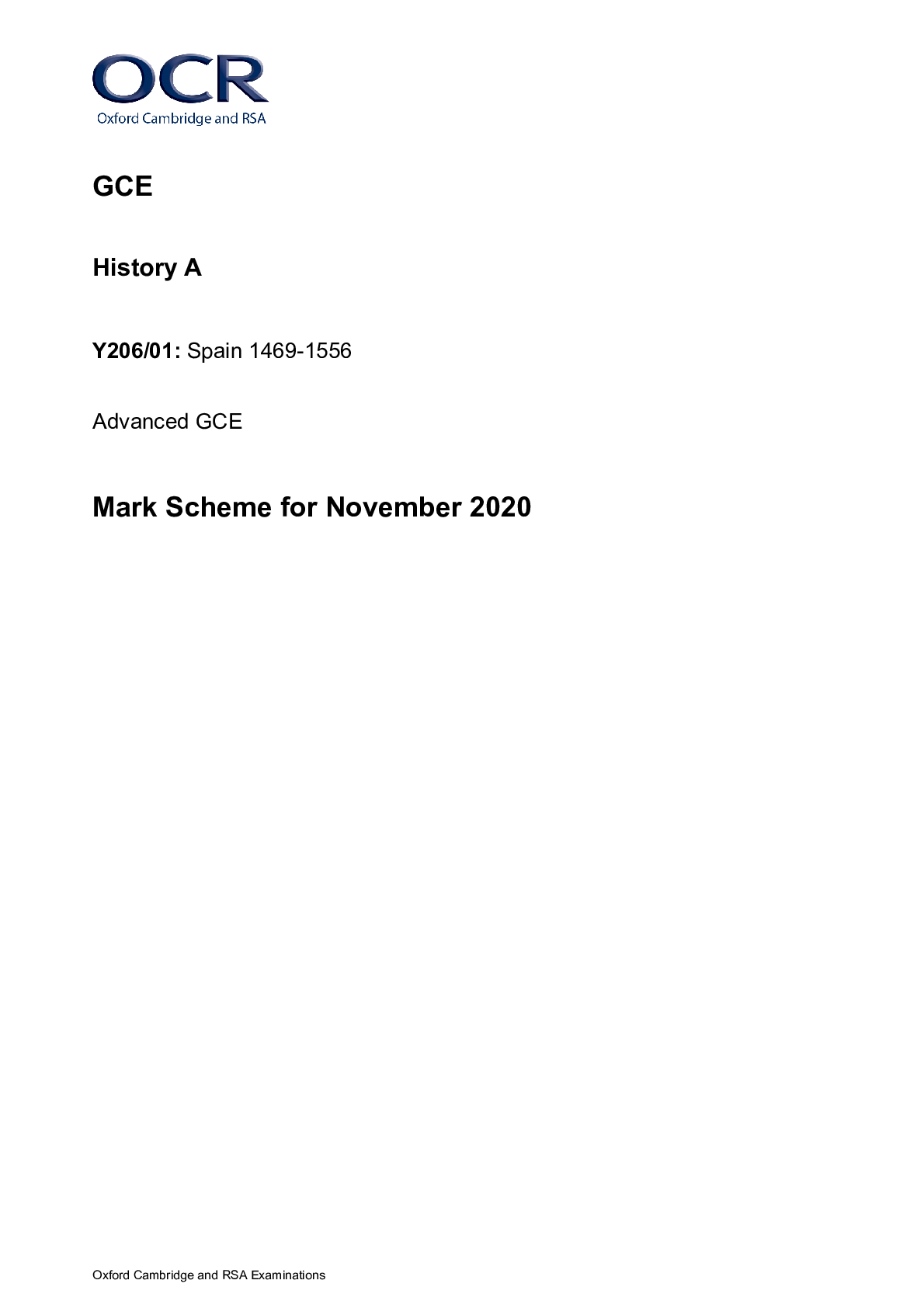
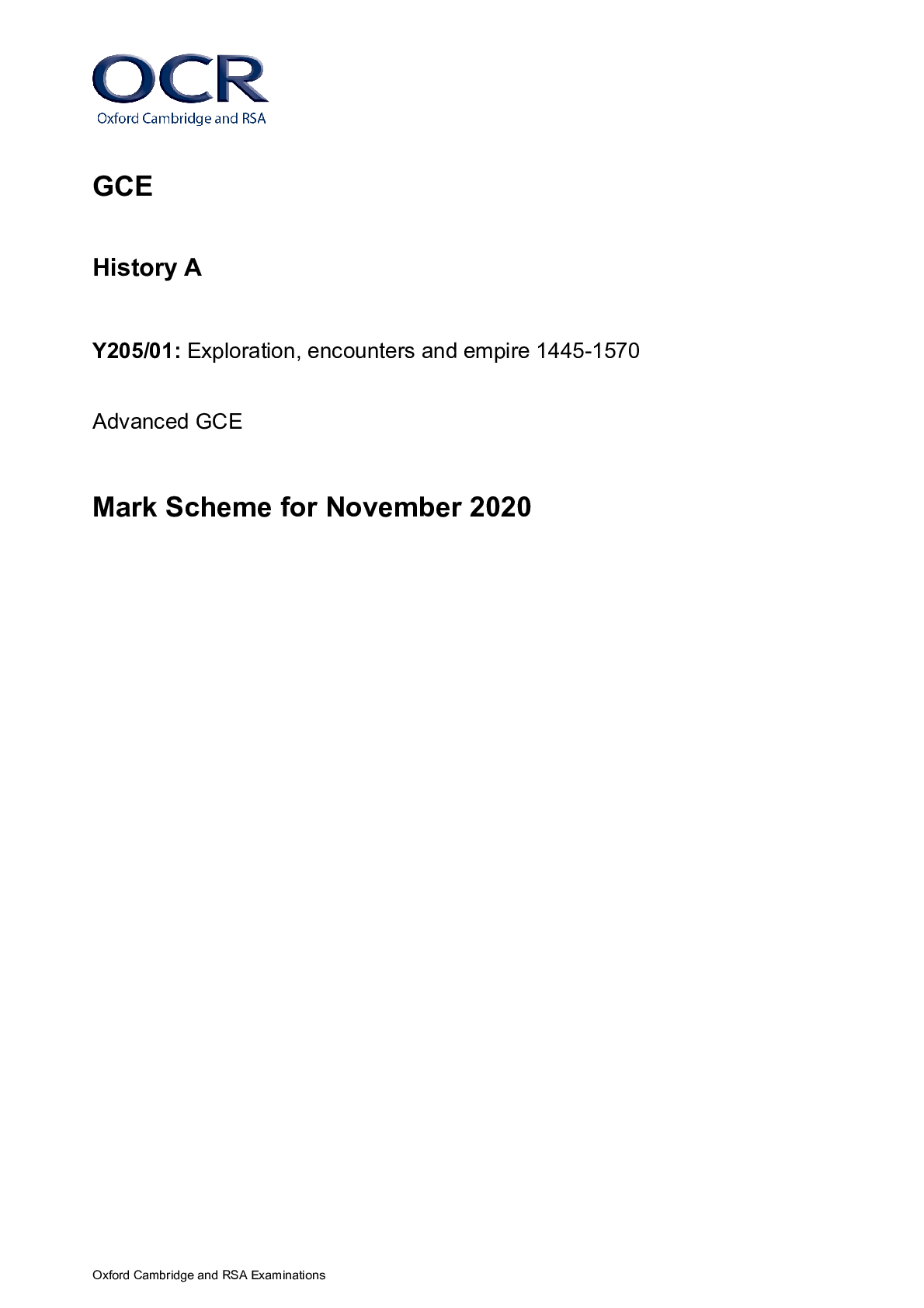






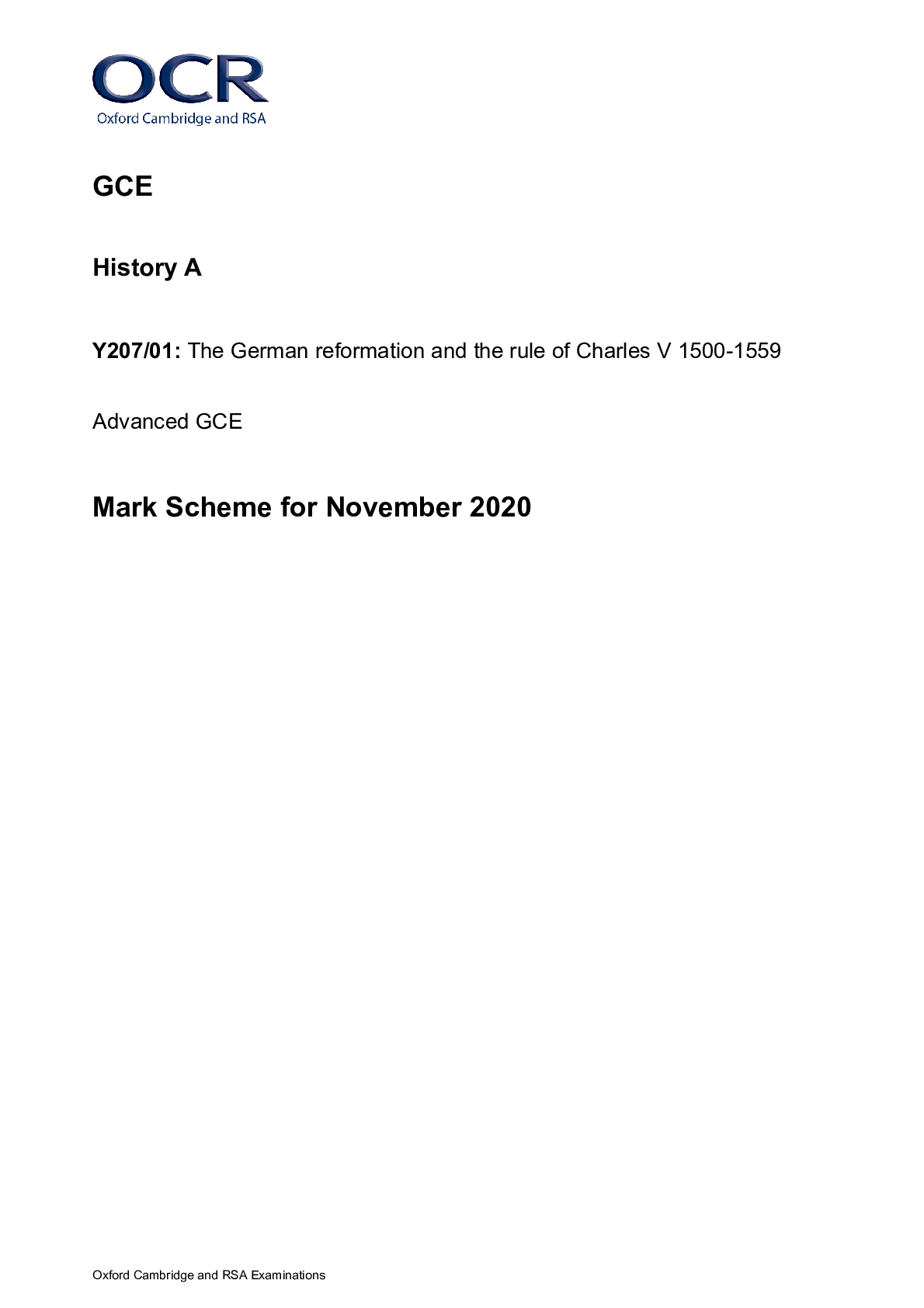






.png)



